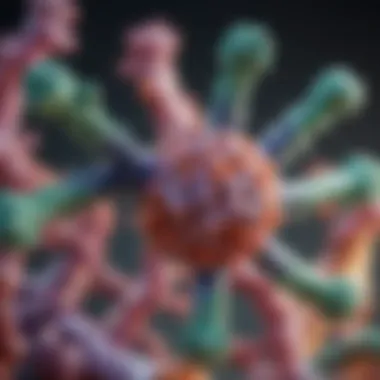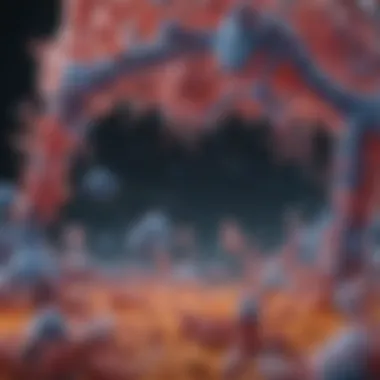Fab Fc Antibody: Structure, Function, and Applications


Intro
Fab Fc antibodies represent a significant advancement in biochemistry and therapeutic development. Their structure and function have drawn considerable interest from the scientific community due to their potential applications in medicine and diagnostics. Understanding these antibodies is crucial for professionals in biotechnology and pharmaceuticals, as well as for students pursuing related fields. This article will explore the nuances of Fab Fc antibodies, elucidating their essential components and roles.
Research Overview
Summary of Key Findings
Recent studies have showcased the dual importance of the Fab and Fc domains in antibody functionality. Fab fragments, known for their specificity towards antigens, play a pivotal role in binding mechanisms. Conversely, the Fc region is instrumental in facilitating immune responses, including opsonization and complement activation. Current research emphasizes the significance of modifying these regions to enhance therapeutic efficacy. This involves engineering antibodies that can better navigate biological environments, prolonging their lifespan and increasing their effectiveness against diseases.
"The synergy between the Fab and Fc regions is fundamental to the effectiveness of monoclonal antibodies in medical applications."
Importance of the Research
The exploration of Fab Fc antibodies is not merely academic. Their implications extend to real-world applications, particularly in immunotherapy and biologics. Advancements in this area can lead to improved treatment modalities for autoimmune disorders, cancers, and infectious diseases. Increased understanding of antibody interactions with the immune system could transform therapeutic strategies, making this research vital.
Methodology
Study Design
The methodology employed in studying Fab Fc antibodies often includes in vitro experiments, often coupled with computational modeling. This helps to simulate interactions between antibodies and their respective antigens. Researchers commonly utilize recombinant DNA technology to produce various antibody fragments, allowing for more detailed analysis of structure-function relationships.
Data Collection Techniques
Data collection techniques in Fab Fc studies include:
- Surface Plasmon Resonance (SPR): Measures the real-time interaction between antibodies and antigens.
- Enzyme-Linked Immunosorbent Assay (ELISA): Quantifies antibody binding affinities and concentrations.
- X-ray Crystallography: Provides insight into the three-dimensional structures of antibody fragments.
These methods collectively enhance the depth of understanding regarding how Fab Fc antibodies can be utilized effectively in therapeutic contexts.
Understanding Antibodies
The study of antibodies plays a critical role in the fields of immunology, biotechnology, and medicine. Antibodies are glycoproteins produced by B cells in response to antigens. They serve as essential components of the immune system, recognizing and binding to foreign substances like bacteria and viruses. Understanding antibodies is pivotal for several reasons.
First, they are vital in the design of diagnostic tests and vaccines. By harnessing the unique properties of antibodies, researchers can create tools that identify pathogens with high specificity. Second, the therapeutic potential of antibodies is significant, especially in treating diseases. Monoclonal antibodies have revolutionized treatment options in oncology and autoimmune disorders.
Moreover, the complexity of antibodies allows for a variety of strategic applications. This article focuses on Fab Fc antibodies, which are particularly intriguing due to their bifunctional capabilities. Grasping the fundamental aspects of antibodies sets the framework for a deeper exploration of their structure, function, and real-world applications. It informs how researchers manipulate these molecules for enhanced performance in both therapeutic and diagnostic contexts.
Basic Structure of Antibodies
Antibodies exhibit a Y-shaped structure comprised primarily of four peptide chains: two heavy chains and two light chains. The antigen-binding sites are located at the tips of the Y, allowing for the specific recognition of antigens. Each antibody has a constant region, which maintains the antibody’s structural integrity, as well as a variable region, where the diversity in binding specificity occurs.
The Fab (Fragment antigen-binding) region consists of the light chain and a part of the heavy chain. This region plays a crucial role in binding to the antigen. In contrast, the Fc (Fragment crystallizable) region is where effector functions are initiated. Understanding this structure is key to grasping how antibodies function in immune response and therapy.
Types of Antibodies
Monoclonal Antibodies
Monoclonal antibodies are derived from a single clone of B cells, which makes them uniform in structure and function. They can specifically target a single epitope, which enhances their efficacy in therapeutic applications. A significant advantage of monoclonal antibodies is their ability to be produced in large quantities. They are a preferred choice for targeted therapies in conditions like cancer. However, their development process can be time-consuming and expensive, which could limit accessibility.
Polyclonal Antibodies
Polyclonal antibodies are produced from multiple B cell clones. This results in a mixture of antibodies that can recognize different epitopes on the same antigen. This characteristic makes them very effective in detecting antigens in complex biological samples. Polyclonal antibodies are widely used in research and diagnostics, providing a broader scope for detection. Nevertheless, their variability can lead to inconsistencies in results, especially in quantitative assays.
Recombinant Antibodies


Recombinant antibodies are engineered using recombinant DNA technology. This allows for precise modifications to enhance their functionality, such as increasing affinity for a target antigen. They can be produced quickly and cost-effectively, making them advantageous in various applications. However, the process of engineering these antibodies requires specialized knowledge and equipment, which might not be available in all research settings.
In summary, each type of antibody brings unique characteristics that contribute to various goals within biotechnology and therapeutic interventions. Understanding these distinctions is significant for selecting the appropriate antibody for specific applications.
Fab and Fc Regions Defined
Understanding the roles and characteristics of Fab and Fc regions is pivotal in the study of antibodies, especially in the context of Fab Fc antibodies. These regions are not just structural components; they serve essential functions that govern how antibodies interact with antigens and immune cells. The Fab region, responsible for antigen binding, plays a critical role in specificity. Meanwhile, the Fc region facilitates effector functions, allowing antibodies to engage with immune systems effectively.
Key insights on Fab and Fc regions include:
- Differential functions: Fab regions bind to specific antigens, while Fc regions mediate interactions with immune cells.
- Therapeutic implications: Understanding these regions aids in designing more effective antibody therapies.
The Fab Fragment Explained
Antigen Binding Function
The antigen binding function of the Fab fragment is fundamental to its role in the immune response. Each Fab region can bind to a unique antigen, which is an essential characteristic for targeting specific pathogens or cancer cells. This binding is driven by the precise interaction between the antibody and the epitope of the antigen.
This unique aspect of the Fab fragment provides significant advantages in therapeutic applications. For instance, monoclonal antibodies like Rituximab are designed to bind specifically to CD20 on B cells, making them effective in treating certain cancers. However, the specificity can also be a limitation when the target antigen is not universally present across affected cells.
Structure and Composition
The structure and composition of the Fab fragment consist of two identical heavy and light chains that form a Y-shape with variable regions at the tips. This configuration allows for a diverse range of antigen-binding sites.
A notable characteristic is the variability within the constant and variable regions, which enhances adaptability in immune response. While this structural feature is beneficial in creating diverse antibodies, it can also lead to challenges in production and standardization, especially in therapeutic settings.
The Fc Portion Unveiled
Role in Immune Response
The Fc portion plays an indispensable role in the immune response by facilitating interactions with various immune cells. This segment of the antibody can bind to Fc receptors on macrophages, natural killer cells, and other immune regulators. This binding triggers cellular responses such as phagocytosis or the release of cytokines.
The ability of the Fc region to mediate these responses is a critical advantage for therapeutic antibodies. For instance, trastuzumab (Herceptin) not only binds to HER2 positive cancer cells but also recruits immune cells to target and destroy these cells. However, the efficacy of the Fc-mediated functions can vary based on the receptor interactions and the presence of immune cell types in the tumor microenvironment.
Interactions with Fc Receptors
Interactions between Fc regions and Fc receptors are central to the functionality of antibodies. These interactions take place through various Fc receptors, each with distinct roles in the immune system. They can enhance antibody-dependent cellular cytotoxicity (ADCC) or complement-dependent cytotoxicity (CDC).
The diverse range of Fc receptors allows for a tailored immune response, which is immensely beneficial in the context of therapeutic applications. However, the complexity of these interactions can lead to variability in how different patients respond to antibody treatments, pointing to the necessity for more research in personalized medicine.
Biochemical Properties of Fab Fc Antibodies
Understanding the biochemical properties of Fab Fc antibodies is essential for comprehending their role in both therapeutic and diagnostic applications. The effectiveness of these antibodies largely stems from their affinity, specificity, stability, and half-life. These factors dictate how well antibodies can interact with antigens, influence the immune response, and serve as reliable tools in biotechnology.
The following sections delve deeper into two critical aspects of these antibodies: affinity and specificity, as well as stability and half-life.
Affinity and Specificity
Affinity refers to the strength of the binding interaction between an antibody and its specific antigen. High affinity is essential for effective immunological responses, as it ensures that antibodies bind tightly to their target, even at low concentrations. This characteristic greatly enhances the efficacy of therapeutic antibodies by allowing for lower doses, thereby minimizing potential side effects.
Specificity, on the other hand, indicates how selectively an antibody binds to its target antigen versus non-specific interactions. This dual concept of affinity and specificity is paramount in antibody design and application. For instance, monoclonal antibodies are engineered for both high affinity and specificity, making them valuable in targeted therapies, such as cancer treatments and autoimmune diseases. The effectiveness of Fab Fc antibodies in therapy depends heavily on these biochemical properties, which require careful evaluation during the development phase.
Stability and Half-Life
Stability is a crucial consideration for Fab Fc antibodies, as it influences their functional lifespan in biological systems. Stable antibodies can endure physiological conditions without denaturing or losing efficacy, making them reliable candidates for therapy and diagnostics. Additionally, engineered antibodies often incorporate modifications that enhance their stability, such as amino acid substitutions that reduce aggregation or improve solubility.


Half-life, which is the time it takes for the concentration of the antibody to decrease by half, greatly influences the dosing schedule in therapeutic applications. Understanding and optimizing the half-life of Fab Fc antibodies allows for greater flexibility in treatment regimens. For instance, antibodies with a longer half-life can be dosed less frequently, providing a more convenient option for patients.
The interplay of affinity, specificity, stability, and half-life fundamentally shapes the practical applications of Fab Fc antibodies. As research in this area progresses, new engineering strategies continue to emerge, enabling even greater precision and effectiveness.
"Understanding the biochemical properties of antibodies is vital not only for their design but also for predicting their behavior in complex biological systems."
Applications in Biotechnology
The applications of Fab Fc antibodies in biotechnology are vast and significant. These antibodies play critical roles in both therapeutic and diagnostic fields. Their unique structure—comprising the Fab and Fc regions—facilitates specific interactions with antigens, enhancing their utility in various biotechnological processes. Understanding these applications is essential for developing effective strategies in the treatment and diagnosis of diseases.
Therapeutic Uses
Monoclonal Antibody Therapies
Monoclonal antibody therapies represent a groundbreaking achievement in medical treatments. These antibodies are designed to target specific antigens on diseased cells, making them highly effective in treating conditions like cancer and autoimmune diseases. A key characteristic of monoclonal antibodies is their uniformity; they are identical and produced from a single clone of cells. This consistency allows for predictable behavior in therapeutic applications,
One major advantage of monoclonal antibody therapies is their ability to be tailored for individual patient needs. They can be engineered to enhance affinity for the target antigen or modified to improve pharmacokinetics. However, these therapies can also be costly and may lead to adverse reactions in some patients.
Fab Fc Fusion Proteins
Fab Fc fusion proteins combine the benefits of both the Fab and Fc regions, creating a versatile tool in therapy. This approach enhances the stability of Fab fragments and allows for prolonged circulation in the bloodstream. Their design enables them to carry therapeutic payloads or facilitate targeted drug delivery, which is significant in improving treatment efficacy.
The fusion of these regions provides a unique advantage; the combined abilities to bind specific antigens and invoke an immune response are enhanced, making them a popular choice in therapeutic interventions. However, challenges exist regarding the complexity of their production and potential immunogenicity.
Diagnostic Techniques
ELISA
The Enzyme-Linked Immunosorbent Assay (ELISA) is a pivotal technique for quantifying the presence of antigens or antibodies in a sample. This method relies on the specific binding properties of antibodies, making it highly sensitive and specific. A significant characteristic of ELISA is its ability to be high-throughput, allowing the simultaneous analysis of multiple samples.
This method is beneficial for its versatility; it can be applied to diagnose conditions ranging from allergies to infectious diseases. However, one downside includes the potential for false positives or negatives, which can lead to misdiagnosis.
Immunohistochemistry
Immunohistochemistry (IHC) is another crucial diagnostic technique that utilizes antibodies to detect specific antigens in tissue sections. This approach allows visualization of protein expression patterns within the cellular context, which is vital in cancer diagnostics.
A highlight of IHC is its capacity for providing crucial information about tissue architecture and cellular interactions. While it is widely accepted in clinical practice, limitations include the variability in antibody quality and the potential for subjectivity in interpretation of results.
In summary, the exploration of Fab Fc antibodies in both therapeutic and diagnostic applications showcases their essential role in advancing modern biotechnology. Their continued development and refinement promise further improvements in disease management and outcomes.
Current Research Advances
Research in Fab Fc antibodies has seen significant growth, with numerous advancements focusing on engineering and therapeutic applications. These developments not only enhance our understanding of antibodies but also expand their utility in tackling complex diseases, thus improving outcomes in clinical practices.
Engineering Fab Fc Antibodies
Methods of Engineering
The methods employed in engineering Fab Fc antibodies have become increasingly sophisticated. Techniques such as phage display, yeast display, and CRISPR/Cas9 gene editing are at the forefront. These methods allow for precise modifications, which enhance the binding affinities and specificities of the antibodies.
Phage display, in particular, has shown remarkable results. It enables researchers to screen vast libraries of antibodies to identify those with the desired properties. This specificity makes it a popular choice in current antibody research. The key characteristic of this method is its ability to rapidly produce a vast array of potential candidates for testing. The downside can be the time required for optimization.
Enhanced Functionality
Enhanced functionality through engineering efforts allows for antibodies that are tailor-made for specific therapeutic roles. This has led to the design of bispecific antibodies, which can bind to two different antigens simultaneously. Such functionality is vital in cancer treatment, where targeting multiple pathways may improve efficacy.


The unique feature here is that these engineered antibodies can potentially work around tumor evasion strategies, making them more effective in treating malignancies. However, the complexity of development can be a challenge, leading to potential safety concerns.
Innovations in Therapeutic Applications
Targeting Cancer Cells
The approach of targeting cancer cells with Fab Fc antibodies represents one of the most promising innovations. This strategy employs antibodies to deliver cytotoxic agents directly to the cancer cells, minimizing damage to surrounding healthy tissues. The selective targeting is a key characteristic that underpins its appeal and clinical relevance.
One notable aspect is the use of antibody-drug conjugates (ADCs), which link the antibody to a potent drug. This method enhances treatment specificity. However, potential resistance from cancer cells remains a significant concern.
Autoimmune Disease Treatments
In the field of treating autoimmune diseases, Fab Fc antibodies also play a crucial role. They can be engineered to block specific immune responses, thus reducing the activity of harmful autoantibodies. This tailored approach can offer a more precise treatment option compared to conventional broad-spectrum immunosuppressants.
The key feature of this application is the targeted modulation of immune pathways. While this specificity presents a distinct advantage, some challenges include the need for long-term monitoring of immune responses to avoid unintended consequences.
The ongoing research in Fab Fc antibodies not only propels therapeutic innovations but also sheds light on intricate disease mechanisms.
Advancements in both engineering and therapeutic applications of Fab Fc antibodies signify a robust area of research. As understanding deepens, the implications for clinical practice continue to evolve, potentially leading to revolutionary treatments that can address complex medical needs.
Regulatory and Ethical Considerations
The regulatory and ethical framework surrounding Fab Fc antibodies is crucial. These antibodies, especially in therapeutic contexts, must undergo rigorous evaluation to ensure patient safety and efficacy. Regulatory considerations involve standard procedures that govern the approval of new antibody therapies. These standards are designed to protect public health by ensuring that products are thoroughly tested before reaching patients.
Approval Processes for Antibody Therapies
The approval process for antibody therapies is both complex and detailed. It typically involves multiple stages, including preclinical testing and various phases of clinical trials. Regulatory bodies like the U.S. Food and Drug Administration (FDA) or the European Medicines Agency (EMA) oversee these processes.
- Preclinical Testing: Before human trials, laboratory and animal studies assess the safety and biological activity of the therapies.
- Phase 1 Trials: A small group of healthy volunteers receives the antibody. This phase focuses on safety and dosage.
- Phase 2 Trials: A larger group of patients with the target condition is studied to evaluate efficacy and side effects.
- Phase 3 Trials: Thousands of participants undergo testing, further confirming efficacy and monitoring adverse reactions before potential approval.
Upon successful completion of these phases, regulatory bodies review the collected data, making decisions that have immense implications on public health and science.
Ethical Implications in Research
The ethical considerations in antibody research are multi-faceted. Key points include:
- Informed Consent: Participants in clinical trials must be fully informed about the study's purpose, potential risks, and benefits. This ensures autonomy and respect for individuals.
- Equitable Access: Fair distribution of therapies is essential, addressing disparities in healthcare access. Researchers must consider how to make new therapies available to various societal groups.
- Animal Welfare: Given that initial testing often involves animal models, ethical standards around their treatment and use are paramount. Values of reduction, refinement, and replacement of animal subjects must be upheld.
"Ethical research practices not only promote trust but also safeguard the integrity of scientific inquiry."
Future Directions
The exploration of Fab Fc antibodies is an ever-evolving field, with promising advancements that reshape therapeutic practices and diagnostic methodologies. As researchers delve deeper, it becomes evident that understanding the nuances of these antibodies holds significant importance for future health solutions.
The continuous enhancements in antibody technology offer various potential benefits. Innovations in bioengineering and molecular design could create antibodies with better specificity, affinity, and stability. These advancements aim to provide tailored therapies that cater to individual patient needs, enhancing treatment efficacy in various conditions, including cancer and autoimmune diseases.
Emerging Trends in Antibody Technology
In recent years, the field of antibody technology has observed some notable trends.
- Bispecific Antibodies: These are engineered to bind two different antigens simultaneously. This dual targeting could lead to improved therapeutic outcomes, especially in cancer treatments where multiple pathways are involved.
- Antibody-Drug Conjugates (ADCs): These combine the specific targeting of antibodies with cytotoxic drugs. The ADCs deliver the drug directly to the cancer cells, minimizing damage to healthy tissues and reducing side effects.
- Single-Cell Sequencing: This technology allows for the detailed analysis of antibody-producing cells. It opens new pathways for discovering novel antibodies and understanding immune responses at an unprecedented level.
With these innovations, the potential to tackle complex diseases becomes more tangible, signaling a new era in therapeutic strategies.
Potential Global Impacts
The advancements in Fab Fc antibody technology promise to have substantial global impacts. To illustrate:
- Enhanced Disease Management: As pharmaceutical companies develop more effective antibody therapies, patients worldwide could experience improved health outcomes. This is crucial for combating diseases like cancer and chronic inflammatory conditions.
- Accessibility in Developing Regions: With advancements in production methods, there may be a reduction in costs, making these therapies more accessible to underserved regions. This shift has the potential to improve healthcare equity globally.
- Collaborative Research Initiatives: The growing interest in antibody technologies fosters collaborations among researchers, institutions, and governments. A global sharing of knowledge can accelerate progress and drive innovation in treatments that affect millions.
Ultimately, the trajectory of Fab Fc antibody research extends far beyond individual therapies, carrying with it the potential to redefine healthcare paradigms around the world. The focus on these antibodies reflects a commitment to bettering patient care and advancing the science of immunology.



